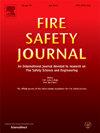森林地表火灾中燃料负荷对蔓延速度和停留时间的非线性影响
IF 3.4
3区 工程技术
Q2 ENGINEERING, CIVIL
引用次数: 0
摘要
森林火灾的频繁和极端,不仅破坏了环境,也给消防人员带来了严重的威胁。了解蔓延速率(ROS)对于制定有效的灭火策略至关重要。地表燃料负荷是森林燃烧的基础,但其对地表火灾活性氧的影响仍存在争议。为了研究燃料负荷对地表火灾活性氧的影响,本研究以松针为燃料材料,通过增加燃料负荷模拟森林地表可燃物的积累,同时考察各负荷条件下的燃料深度和填充比。利用一个能够测量火线沿线多个点ROS的实验系统,我们评估了在0.4-3.0 kg/m2的燃料负荷范围内表面火灾的ROS。讨论了不同负荷条件下填料比和燃料深度对活性氧的影响,并探讨了燃料负荷对火线停留时间的影响。结果表明,由于松针的可压缩性和重量的影响,燃料负荷的增加会导致更高的填料比和更大的燃料床深度。在研究的负荷范围内,ROS不遵循简单的线性趋势;相反,它开始上升,然后下降,最后显示缓慢增长。这种非线性行为源于填料比和燃料深度对活性氧的综合影响,有时是相反的影响。此外,随着燃料负荷的增加,火线停留时间呈缓慢增加-急剧上升-逐渐进一步增加的趋势。在高燃料负荷的驱动下,火焰深度的增长最终成为延长停留时间的主要因素。这些发现为加强对森林地表火灾动态和燃料负荷效应的理解提供了有价值的实验数据。本文章由计算机程序翻译,如有差异,请以英文原文为准。
Nonlinear impacts of fuel load on rate of spread and residence time in forest surface fires
Frequent and extreme forest fires not only damage the environment but also pose a serious threat to firefighting personnel. Understanding the rate of spread (ROS) is crucial for developing effective firefighting strategies. Surface fuel load serves as the foundation for forest combustion, yet its effect on the ROS of surface fires remains contentious. To investigate the impact of fuel load on surface fire ROS, this study uses pine needles as the fuel material, simulating the accumulation of surface combustibles in forests by increasing fuel load, while also examining fuel depth and packing ratio under each load condition. Using an experimental system capable of measuring the ROS at multiple points along the fire line, we evaluated the ROS of surface fires within a fuel load range of 0.4–3.0 kg/m2. The effects of packing ratio and fuel depth on ROS under different load conditions were discussed, and the influence of fuel load on fire line residence time was also explored. The results indicate that increasing fuel load leads to higher packing ratios and greater fuel bed depth due to the compressibility and weight of the pine needles. Within the studied load range, ROS does not follow a simple linear trend; instead, it initially rises, then decreases, and finally shows a slow increase. This non-linear behavior arises from the combined, and at times opposing, effects of packing ratio and fuel depth on ROS. Additionally, as fuel load increases, the residence time of the fire line follows a pattern of slow increase, sharp rise, and gradual further increase. The growth in flame depth, driven by higher fuel loads, ultimately becomes the dominant factor in prolonging the residence time. These findings provide valuable experimental data to enhance the understanding of forest surface fire dynamics and fuel load effects.
求助全文
通过发布文献求助,成功后即可免费获取论文全文。
去求助
来源期刊

Fire Safety Journal
工程技术-材料科学:综合
CiteScore
5.70
自引率
9.70%
发文量
153
审稿时长
60 days
期刊介绍:
Fire Safety Journal is the leading publication dealing with all aspects of fire safety engineering. Its scope is purposefully wide, as it is deemed important to encourage papers from all sources within this multidisciplinary subject, thus providing a forum for its further development as a distinct engineering discipline. This is an essential step towards gaining a status equal to that enjoyed by the other engineering disciplines.
 求助内容:
求助内容: 应助结果提醒方式:
应助结果提醒方式:


